Roberto Caldelli
Exploring Strengths and Weaknesses of Super-Resolution Attack in Deepfake Detection
Oct 05, 2024Abstract:Image manipulation is rapidly evolving, allowing the creation of credible content that can be used to bend reality. Although the results of deepfake detectors are promising, deepfakes can be made even more complicated to detect through adversarial attacks. They aim to further manipulate the image to camouflage deepfakes' artifacts or to insert signals making the image appear pristine. In this paper, we further explore the potential of super-resolution attacks based on different super-resolution techniques and with different scales that can impact the performance of deepfake detectors with more or less intensity. We also evaluated the impact of the attack on more diverse datasets discovering that the super-resolution process is effective in hiding the artifacts introduced by deepfake generation models but fails in hiding the traces contained in fully synthetic images. Finally, we propose some changes to the detectors' training process to improve their robustness to this kind of attack.
Deepfake Media Forensics: State of the Art and Challenges Ahead
Aug 01, 2024Abstract:AI-generated synthetic media, also called Deepfakes, have significantly influenced so many domains, from entertainment to cybersecurity. Generative Adversarial Networks (GANs) and Diffusion Models (DMs) are the main frameworks used to create Deepfakes, producing highly realistic yet fabricated content. While these technologies open up new creative possibilities, they also bring substantial ethical and security risks due to their potential misuse. The rise of such advanced media has led to the development of a cognitive bias known as Impostor Bias, where individuals doubt the authenticity of multimedia due to the awareness of AI's capabilities. As a result, Deepfake detection has become a vital area of research, focusing on identifying subtle inconsistencies and artifacts with machine learning techniques, especially Convolutional Neural Networks (CNNs). Research in forensic Deepfake technology encompasses five main areas: detection, attribution and recognition, passive authentication, detection in realistic scenarios, and active authentication. Each area tackles specific challenges, from tracing the origins of synthetic media and examining its inherent characteristics for authenticity. This paper reviews the primary algorithms that address these challenges, examining their advantages, limitations, and future prospects.
Adversarial Magnification to Deceive Deepfake Detection through Super Resolution
Jul 02, 2024



Abstract:Deepfake technology is rapidly advancing, posing significant challenges to the detection of manipulated media content. Parallel to that, some adversarial attack techniques have been developed to fool the deepfake detectors and make deepfakes even more difficult to be detected. This paper explores the application of super resolution techniques as a possible adversarial attack in deepfake detection. Through our experiments, we demonstrate that minimal changes made by these methods in the visual appearance of images can have a profound impact on the performance of deepfake detection systems. We propose a novel attack using super resolution as a quick, black-box and effective method to camouflage fake images and/or generate false alarms on pristine images. Our results indicate that the usage of super resolution can significantly impair the accuracy of deepfake detectors, thereby highlighting the vulnerability of such systems to adversarial attacks. The code to reproduce our experiments is available at: https://github.com/davide-coccomini/Adversarial-Magnification-to-Deceive-Deepfake-Detection-through-Super-Resolution
Deepfake Detection without Deepfakes: Generalization via Synthetic Frequency Patterns Injection
Mar 20, 2024Abstract:Deepfake detectors are typically trained on large sets of pristine and generated images, resulting in limited generalization capacity; they excel at identifying deepfakes created through methods encountered during training but struggle with those generated by unknown techniques. This paper introduces a learning approach aimed at significantly enhancing the generalization capabilities of deepfake detectors. Our method takes inspiration from the unique "fingerprints" that image generation processes consistently introduce into the frequency domain. These fingerprints manifest as structured and distinctly recognizable frequency patterns. We propose to train detectors using only pristine images injecting in part of them crafted frequency patterns, simulating the effects of various deepfake generation techniques without being specific to any. These synthetic patterns are based on generic shapes, grids, or auras. We evaluated our approach using diverse architectures across 25 different generation methods. The models trained with our approach were able to perform state-of-the-art deepfake detection, demonstrating also superior generalization capabilities in comparison with previous methods. Indeed, they are untied to any specific generation technique and can effectively identify deepfakes regardless of how they were made.
Deepfake detection by exploiting surface anomalies: the SurFake approach
Oct 31, 2023



Abstract:The ever-increasing use of synthetically generated content in different sectors of our everyday life, one for all media information, poses a strong need for deepfake detection tools in order to avoid the proliferation of altered messages. The process to identify manipulated content, in particular images and videos, is basically performed by looking for the presence of some inconsistencies and/or anomalies specifically due to the fake generation process. Different techniques exist in the scientific literature that exploit diverse ad-hoc features in order to highlight possible modifications. In this paper, we propose to investigate how deepfake creation can impact on the characteristics that the whole scene had at the time of the acquisition. In particular, when an image (video) is captured the overall geometry of the scene (e.g. surfaces) and the acquisition process (e.g. illumination) determine a univocal environment that is directly represented by the image pixel values; all these intrinsic relations are possibly changed by the deepfake generation process. By resorting to the analysis of the characteristics of the surfaces depicted in the image it is possible to obtain a descriptor usable to train a CNN for deepfake detection: we refer to such an approach as SurFake. Experimental results carried out on the FF++ dataset for different kinds of deepfake forgeries and diverse deep learning models confirm that such a feature can be adopted to discriminate between pristine and altered images; furthermore, experiments witness that it can also be combined with visual data to provide a certain improvement in terms of detection accuracy.
Optical identification using physical unclonable functions
May 03, 2023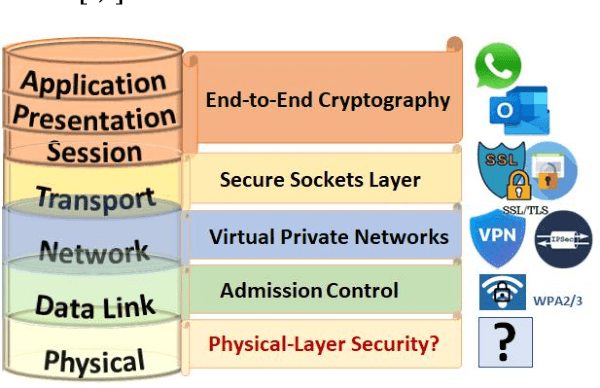
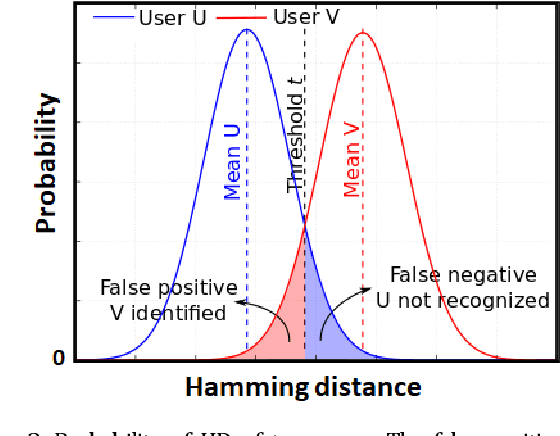
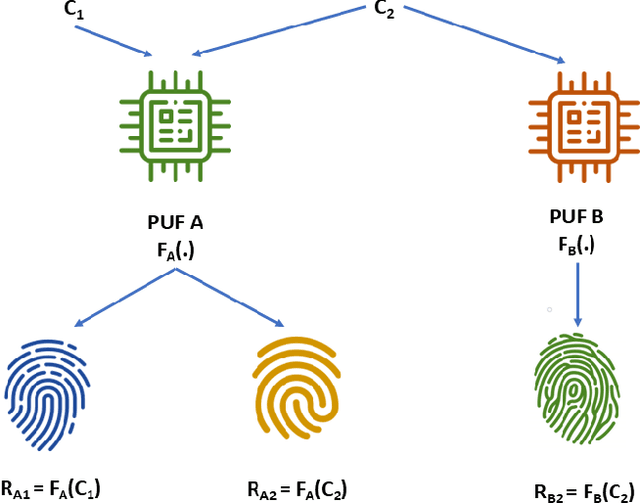
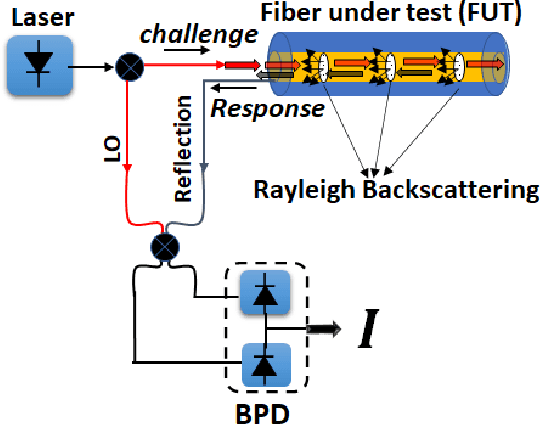
Abstract:In this work, the concept of optical identification (OI) is introduced for the first time. The OI assigns an optical fingerprint and the corresponding digital signature to each sub-system of the network and estimates its reliability in different measures. We highlight the large potential applications of OI as a physical layer approach for security, identification, authentication, and monitoring purposes. To identify most of the sub-systems of a network, we propose to use the Rayleigh backscattering pattern, which is an optical physical unclonable function and allows to achieve OI with a simple procedure and without additional devices. The application of OI to fiber and path identification in a network, and to the authentication of the users in a quantum key distribution system are described.
MINTIME: Multi-Identity Size-Invariant Video Deepfake Detection
Dec 07, 2022Abstract:In this paper, we introduce MINTIME, a video deepfake detection approach that captures spatial and temporal anomalies and handles instances of multiple people in the same video and variations in face sizes. Previous approaches disregard such information either by using simple a-posteriori aggregation schemes, i.e., average or max operation, or using only one identity for the inference, i.e., the largest one. On the contrary, the proposed approach builds on a Spatio-Temporal TimeSformer combined with a Convolutional Neural Network backbone to capture spatio-temporal anomalies from the face sequences of multiple identities depicted in a video. This is achieved through an Identity-aware Attention mechanism that attends to each face sequence independently based on a masking operation and facilitates video-level aggregation. In addition, two novel embeddings are employed: (i) the Temporal Coherent Positional Embedding that encodes each face sequence's temporal information and (ii) the Size Embedding that encodes the size of the faces as a ratio to the video frame size. These extensions allow our system to adapt particularly well in the wild by learning how to aggregate information of multiple identities, which is usually disregarded by other methods in the literature. It achieves state-of-the-art results on the ForgeryNet dataset with an improvement of up to 14% AUC in videos containing multiple people and demonstrates ample generalization capabilities in cross-forgery and cross-dataset settings. The code is publicly available at https://github.com/davide-coccomini/MINTIME-Multi-Identity-size-iNvariant-TIMEsformer-for-Video-Deepfake-Detection.
Cross-Forgery Analysis of Vision Transformers and CNNs for Deepfake Image Detection
Jun 28, 2022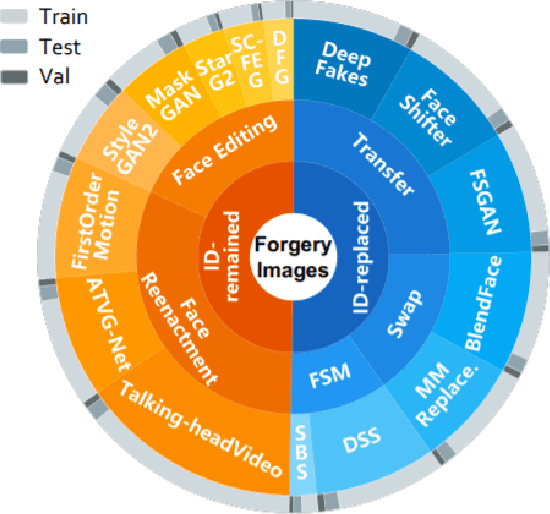
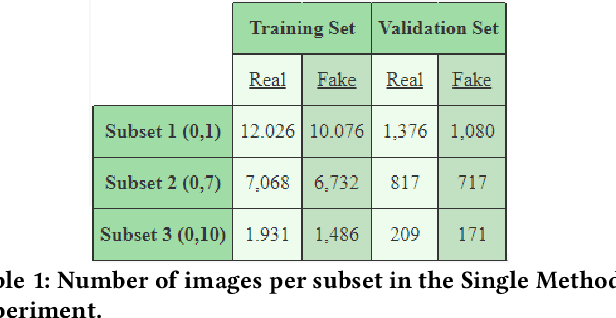

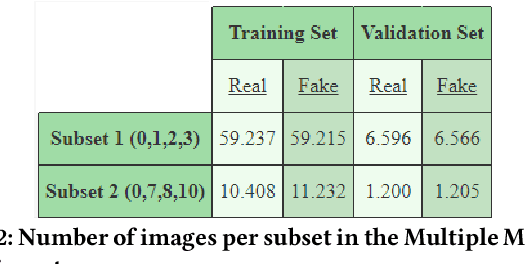
Abstract:Deepfake Generation Techniques are evolving at a rapid pace, making it possible to create realistic manipulated images and videos and endangering the serenity of modern society. The continual emergence of new and varied techniques brings with it a further problem to be faced, namely the ability of deepfake detection models to update themselves promptly in order to be able to identify manipulations carried out using even the most recent methods. This is an extremely complex problem to solve, as training a model requires large amounts of data, which are difficult to obtain if the deepfake generation method is too recent. Moreover, continuously retraining a network would be unfeasible. In this paper, we ask ourselves if, among the various deep learning techniques, there is one that is able to generalise the concept of deepfake to such an extent that it does not remain tied to one or more specific deepfake generation methods used in the training set. We compared a Vision Transformer with an EfficientNetV2 on a cross-forgery context based on the ForgeryNet dataset. From our experiments, It emerges that EfficientNetV2 has a greater tendency to specialize often obtaining better results on training methods while Vision Transformers exhibit a superior generalization ability that makes them more competent even on images generated with new methodologies.
 Add to Chrome
Add to Chrome Add to Firefox
Add to Firefox Add to Edge
Add to Edge